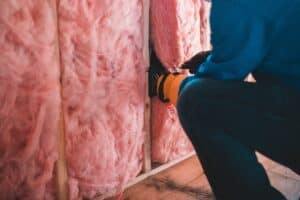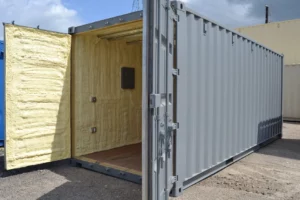How To Insulate a Storage Container: From the Elements
Looking to insulate your storage container from the elements? In this article, we’ll show you how to insulate it effectively.
You’ll discover the best types of insulation to use and why it’s crucial for maintaining a comfortable indoor environment.
We’ll guide you through various insulation options, weighing the pros and cons of each.
Plus, we’ll provide expert answers to common questions and offer valuable recommendations.
Don’t let temperature fluctuations ruin your stored items – let’s get started on insulating your storage container today!
Best Shipping Container Insulation Types
The best shipping container insulation types can significantly improve the temperature regulation inside the storage container. When it comes to insulating your shipping container, there are several options to consider.
One popular choice is spray foam insulation. This type of insulation is applied as a liquid and expands into a foam, filling in any gaps and creating an airtight seal.
Another option is foam insulation, which comes in rigid panels that can be cut to fit the container walls.
Expanded foam insulation is another effective choice. It is made from polystyrene beads that are expanded and molded into panels.
Lastly, polyurethane spray foam insulation is a versatile option that can be applied to the container walls, providing excellent insulation and moisture resistance.
Consider these options to ensure your shipping container remains well-insulated and protected from extreme temperatures.
Importance of Insulation in Shipping Container Homes
The importance of insulation in shipping container homes cannot be overstated. When it comes to creating a comfortable and energy-efficient living space, insulating your shipping containers is crucial.
Without proper insulation, these containers can become unbearably hot in the summer and freezing cold in the winter. Insulation helps regulate the temperature inside the container, making it more livable and reducing the need for excessive heating or cooling.
There are various insulation materials available for insulating shipping containers, including spray foam, rigid foam boards, and ceramic insulation. These materials provide excellent thermal resistance and can effectively prevent heat transfer.
Insulating your shipping container home not only improves comfort but also helps in reducing energy consumption and lowering utility bills. So, don’t underestimate the importance of insulation when it comes to transforming shipping containers into cozy and sustainable living spaces.

Barrier Between Conditioned Indoor Environment and External Temperature Fluctuations
Maintaining a barrier between the conditioned indoor environment and external temperature fluctuations is essential for creating a comfortable living space in shipping container homes.
To achieve this, you need to choose the right insulation material and install a vapor barrier. The insulation material helps regulate the temperature inside the container by reducing heat transfer. You can install it on the interior walls to create a thermal envelope.
Additionally, adding exterior insulation to the container walls can provide even better insulation performance. The vapor barrier, on the other hand, prevents moisture from seeping into the insulation, ensuring its effectiveness.
Guide on Various Insulation Types
When selecting insulation for your shipping container home, it’s crucial to consider factors such as cost, R-value, and ease of installation.
There are several insulation options to choose from, including spray foam insulation, blanket insulation, fiberglass insulation, mineral wool, and cellulose insulation.
Spray foam insulation provides excellent coverage and seals any gaps or cracks, but it can be costly.
Blanket insulation is another popular choice, as it is affordable and easy to install.
Fiberglass insulation is a common option, offering good thermal performance and affordability.
Mineral wool is known for its fire-resistant properties and soundproofing capabilities.
Lastly, cellulose insulation is made from recycled materials and is environmentally friendly.
Consider your budget, insulation needs, and installation requirements when deciding on the best insulation type for your shipping container home.
Pros and Cons of Each Insulation Type
Each insulation type has its own advantages and disadvantages to consider when selecting the best option for your shipping container home.
Spray foam insulation is a popular choice due to its excellent insulating properties and ability to effectively seal gaps and cracks. However, it can be quite expensive and requires professional installation.
Expanded polystyrene foam insulation is another option that offers good thermal resistance and is relatively affordable.
Denim insulation, made from recycled jeans, is environmentally friendly and easy to install. However, it may not provide as much insulation as other types.
Rock wool insulation is fire-resistant and provides excellent soundproofing, but it can be more expensive and may require special handling.
Lastly, closed cell foam insulation offers high R-values and moisture resistance, but it is also the most expensive option.
Consider your budget, insulation needs, and other factors when choosing the best insulation type for your shipping container home.
Choosing the Best Insulation Based on Individual Needs
To determine the best insulation for your shipping container home, you should consider your specific needs and requirements.
If you’re looking for an insulation that expands to fill gaps and create an airtight seal, spray foam insulation is your best bet. It provides excellent thermal insulation and can reduce energy costs.
Closed cell foam sheets are another option, offering high insulation value and moisture resistance.
If you prefer a more traditional approach, batt insulation is a popular choice. It’s easy to install and provides good thermal performance.
Mineral wool insulation is a great option if you’re concerned about fire safety, as it is non-combustible.
Lastly, insulation panels are a convenient option, offering both insulation and structural support.
Consider these options and choose the one that best suits your needs for a comfortable and energy-efficient shipping container home.
Factors Influencing Choice: Size of the Container, Geography, Climate, Price, and Quality
Consider your specific needs and requirements when choosing insulation for your shipping container home. Take into account factors such as the size of the container, geography, climate, price, and quality.
Insulating a storage container is crucial to maintain a comfortable living environment and protect your belongings. The size of the container will determine the amount of insulation needed, as larger containers require more materials.
Geography plays a role in insulation choice because different regions have varying temperature ranges and weather conditions. The climate is another important factor to consider, as extreme temperatures or high humidity levels may require specialized insulation.
Price and quality are also significant considerations, as you want to strike a balance between affordability and effectiveness. By considering these factors, you can choose the right insulation for your storage container, ensuring optimal comfort and protection.
Non-Traditional Insulation Methods
Using unconventional materials for insulation, such as recycled denim or straw bales, can provide unique and eco-friendly options for your shipping container home.
If you’re looking for a quick and efficient solution, consider using spray foam insulation. It’s easy to apply and provides a seamless and airtight barrier against the elements.
For those who prefer to use recycled materials, cork insulation is a great choice. Cork is a natural and renewable resource that offers excellent thermal insulation properties.
Another option is perlite insulation, which is made from volcanic rock and is lightweight and fire-resistant.
If safety is a top priority for you, consider a non-flammable insulation option such as mineral wool.
With these non-traditional insulation methods, you can create a comfortable and energy-efficient living space inside your shipping container home.
Impact of Climate on Insulation Decisions
Now that you understand non-traditional insulation methods, let’s talk about the impact of climate on your insulation decisions for your storage container.
The climate in your area will greatly affect the type and thickness of insulation you need. If you live in a hot climate, you’ll want insulation that can keep the interior of the container cool and prevent heat from seeping in. On the other hand, if you reside in a cold climate, your focus will be on insulation that keeps the container warm and prevents heat loss.
The elements, such as rain, snow, and wind, can also play a role in the effectiveness of your insulation. It’s important to consider all these factors when making insulation decisions for your storage container to ensure it remains well-protected from the harsh elements.
Other Thermal Energy Control Ideas
To efficiently control thermal energy in your storage container, you may want to explore alternative methods such as reflective coatings or radiant barriers. These techniques can greatly enhance the insulation of your shipping container, whether you are using it for storage or as a container home.
Reflective coatings work by reflecting heat away from the container, preventing it from entering in the first place. Radiant barriers, on the other hand, are designed to reflect radiant heat back into the container, keeping it warm in colder climates.
Both of these methods are effective in insulating shipping containers and can help you create a comfortable and energy-efficient space. So, consider incorporating reflective coatings or radiant barriers when insulating a shipping container for your specific needs.
Understanding Insulation
Understanding insulation is essential for creating a well-insulated and energy-efficient space in your shipping container.
When it comes to insulating the interior of your container, there are various insulation methods to consider. One popular option is to use complete wall cavity containment, where the insulation is installed within the entire wall cavity. This method ensures that there are no gaps or spaces for air leakage, providing maximum insulation.
Another option is cheap wall insulation, which is a cost-effective solution for those on a tight budget. This type of insulation may not provide the same level of thermal performance as other methods, but it can still help to improve the overall insulation of your container.
Functionality of Insulation
Using complete wall cavity containment when insulating your shipping container ensures maximum insulation by eliminating gaps or spaces for air leakage. This is essential for maintaining the functionality of insulation and protecting your stored items from the elements.
Proper insulation creates a barrier that prevents heat transfer, keeping the interior temperature stable and minimizing the impact of external conditions. By insulating your storage container, you can effectively regulate the temperature inside, protecting your belongings from extreme heat or cold.
Additionally, insulation helps to prevent moisture build-up, reducing the risk of mold and mildew growth. It also provides soundproofing benefits, ensuring a quieter environment for your stored items.
Overall, insulating your storage container is crucial for maintaining its functionality and protecting its contents from the elements.
Significance in Shipping Container Homes With Metal Exteriors
Now that you understand the functionality of insulation, let’s discuss its significance in shipping container homes with metal exteriors.
When it comes to insulating shipping containers, the exterior walls play a crucial role in maintaining a comfortable living environment. Metal exteriors can conduct heat and cold, making it essential to insulate them properly.
Insulating the walls of your shipping container home is vital to keep the interior temperature regulated and protect against the elements. There are various insulation options available to ensure that your home remains cozy and energy-efficient. From spray foam insulation to rigid foam boards, you can choose the best option based on your budget and needs.
Properly insulating the exterior walls of your shipping container home will not only provide comfort but also reduce energy consumption.
Factors Influencing Choice
When choosing insulation for your shipping container home, there are several factors to consider: climate, budget, and desired level of energy efficiency. The right insulation can help regulate temperature and save on heating and cooling costs.
There are various options available, each with its own advantages. Styrofoam insulation is a popular choice due to its high thermal insulation properties. It is lightweight, easy to install, and offers excellent moisture resistance.
Recycled glass insulation is environmentally friendly and provides good thermal and sound insulation. It is a sustainable option that helps reduce waste.
Natural foam pellets, made from plant-based materials, are another sustainable option. These pellets expand to fill gaps and provide effective insulation. They are a great choice for those looking for eco-friendly options.
Small plastic beads are also commonly used as insulation material. They are lightweight and offer good thermal insulation. They are easy to install and provide effective insulation.
Consider these options to find the perfect insulation for your shipping container home. Each option has its own advantages, so take into account your specific needs and preferences.
Key Considerations for Selecting Insulation
To select the right insulation for your shipping container home, consider factors such as climate, budget, and desired level of energy efficiency. Proper insulation is crucial to keep your home comfortable and energy-efficient.
When adding insulation, it’s important to consider the R-value, which measures the material’s resistance to heat flow. The higher the R-value, the better the insulation’s performance.
One popular option for shipping container homes is closed cell spray foam insulation. It provides excellent insulation properties and creates an airtight barrier, preventing heat loss and air leakage. This type of insulation has a high R-value, making it ideal for homes in extreme climates.
Balancing Cost, Eco-Friendliness, and Performance
Consider how you can balance cost, eco-friendliness, and performance when choosing insulation for your shipping container home.
One option to explore is external insulation, which involves adding insulation to the outside of your container. This method is effective in reducing heat transfer and can provide a high R-value, meaning it has excellent thermal resistance.
When selecting insulation, look for eco-friendly materials such as recycled or natural fibers. These options not only help reduce waste but also contribute to a healthier environment.
Additionally, consider incorporating vapor barriers into your insulation system. These barriers help prevent moisture from entering your container, reducing the risk of condensation and mold growth.
Alternative Insulation Methods
One option for achieving proper insulation in your shipping container home is by exploring alternative methods that balance cost, performance, and eco-friendliness.
When it comes to insulating a storage container, there are several alternative insulation methods you can consider. One option is to use spray foam insulation, which provides a seamless and airtight barrier, preventing heat loss and reducing energy consumption.
Another alternative is to use recycled denim insulation, which is eco-friendly and effective in maintaining a comfortable indoor temperature.
Additionally, you can explore the option of using rigid foam insulation boards, which are durable, lightweight, and provide excellent thermal insulation.
Whichever alternative insulation method you choose, make sure to properly install insulation to ensure maximum efficiency and comfort in your insulated shipping container home.
Unconventional or Passive Methods To Regulate Temperature
If you’re looking for unconventional or passive methods to regulate temperature in your shipping container home, you can explore options such as using reflective roofing materials or incorporating green roofs.
Reflective roofing materials, like metal or white coatings, can help reflect sunlight and reduce heat absorption.
Green roofs, on the other hand, involve covering the roof with vegetation, which provides insulation and helps regulate temperature.
Another unconventional option to consider is loose fill insulation, which consists of small particles like cellulose or mineral wool that can be blown into the walls or ceiling cavities of your container home.
Open cell foam cells are also a viable alternative, as they provide excellent thermal insulation and can be sprayed into hard-to-reach areas.
Lastly, cork trees can be harvested for their bark, which is an excellent natural insulation material.
You can also consider using fiberglass batts, which are easy to install and offer good thermal resistance.
How to Insulate a Shipping Container
There are various unconventional methods to regulate the temperature in a shipping container home. However, if you want to ensure proper insulation and protection from the elements, it’s important to know how to insulate a storage container effectively.
The insulation process involves creating wall cavities within the container. These cavities can be filled with insulation materials such as spray foam or rigid foam boards. To further enhance the insulation, you can add exterior cladding, such as wood or metal siding, to create an additional barrier against heat transfer.
Inside the container, you can also insulate the interior space with materials like polystyrene panels or fiberglass batts. By properly insulating your shipping container, you can maintain a comfortable temperature and protect your home from extreme weather conditions.
Step-by-Step Guide
To effectively regulate the temperature in your shipping container home, start by creating wall cavities and filling them with insulation materials. Use materials like spray foam or rigid foam boards. Insulation is crucial for preventing heat transfer and reducing energy consumption.
When deciding how much insulation to use, consider the heat conduction properties of the materials. Spray foam insulation is known for its high R-value, which indicates its ability to resist heat conduction. Rigid foam boards, on the other hand, provide excellent insulation due to their dense structure and thin fibers.
These materials help to minimize cooling costs and maintain a comfortable interior temperature. Additionally, make sure the insulation materials you choose fit typical wall heights to ensure complete coverage and maximum efficiency.
Tools and Materials Needed
You’ll need several tools and materials for this project. These items are essential for insulating your storage container and protecting it from the elements: a stud finder, measuring tape, utility knife, and a caulking gun.
When insulating the internal walls, start by using a stud finder to locate the wooden studs. Measure the space between them and cut foam panels to fit. Fill any large air gaps with expanding foam.
For an eco-friendly option, consider using recycled paper products as insulation. Install a vapour barrier to prevent moisture buildup. Use the utility knife and caulking gun to seal any gaps and ensure a tight seal.
With the right tools and materials, you can effectively insulate your storage container and protect its contents.
Safety Precautions
Using proper safety precautions is crucial when working with tools and materials for this project.
When insulating a storage container, it is important to consider the heat conduction properties of the insulation material.
Make sure to wear protective gloves and goggles to avoid any accidents.
Additionally, when dealing with molten material, such as foam insulation, be cautious of the high temperatures and take necessary measures to prevent burns.
It is recommended to use fire retardant and water-resistant insulation to ensure the safety of the storage container.
Before starting the insulation process, ensure proper ventilation to avoid inhaling any harmful fumes.
Lastly, always keep a fire extinguisher nearby in case of any emergencies.
Frequently Asked Questions
What is the cheapest way to insulate a storage container?
The cheapest way to insulate a storage container is by using “cheap wall insulation.” This method may not provide the same level of thermal performance as other options but is cost-effective.
How do you insulate a shipping container for cold weather?
To insulate a shipping container for cold weather, you can use various methods. One effective approach is to create wall cavities within the container and fill them with insulation materials like spray foam or rigid foam boards. Additionally, consider external insulation and vapor barriers to prevent heat loss and moisture buildup.
What is the best way to insulate a shipping container home?
The best way to insulate a shipping container home depends on various factors, including your specific needs and budget. Some effective options include closed cell spray foam insulation, which provides excellent thermal insulation and creates an airtight seal. Other choices include recycled denim insulation for eco-friendliness or rigid foam boards for their durability and insulation properties. Consult with professionals to determine the most suitable approach for your container home.
Is it better to insulate the outside or inside of a shipping container?
Whether it’s better to insulate the outside or inside of a shipping container depends on your goals and budget. Insulating the inside is a common practice and can be effective in regulating temperature and protecting against the elements. However, external insulation can also provide excellent insulation properties and is especially useful in extreme climates. The choice between inside and outside insulation should consider factors like climate, budget, and desired energy efficiency.
Expert Answers and Recommendations
If you’re concerned about the effectiveness of insulation in a high cube container, rest assured that it will still work effectively. Insulation is made up of tiny microscopic cells that trap air, preventing heat transfer.
In a high cube container, the insulation material, such as long rolled up pieces of slag wool, can be strategically placed to cover the walls, ceiling, and floor. This helps to create a barrier between the interior and exterior, keeping the temperature regulated and preventing moisture build-up.
The insulation acts as a thermal barrier, reducing heat loss in cold weather and heat gain in hot weather. It also helps to minimize condensation and dampness inside the container.
Conclusion
So there you have it, you now know how to insulate a storage container from the elements!
By choosing the best insulation types and creating a barrier between the indoor environment and external temperature fluctuations, you can ensure a comfortable and energy-efficient space.
Remember to consider the pros and cons of each insulation type and take the necessary safety precautions during installation.
If you still have questions, refer to our frequently asked questions section for expert answers and recommendations.
Happy insulating!



